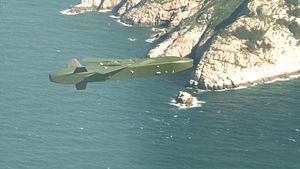South Korea has concluded a contract for 90 German-built Taurus KEPD 350 long-range precision-guided cruise missiles, the country’s Defense Acquisition Program Administration (DAPA) revealed on March 12. “The contract was signed in late February,” Kang Hwan-seok, a DAPA spokesperson, told reporters this Monday, according to Yonhap news agency.
The 90 additional Taurus KEPD 350 air-to-surface missiles will expand the Republic of Korea Air Force’s (ROKAF) existing stockpile of 170-180 missiles. The ROKAF began receiving its first Taurus KEPD 350s, intended for the service’s fleet of F-15K Slam Eagle multirole fighter jets, in October 2016.The cost per missile is estimated at around $1.2 million.
Powered by a turbofan engine, the Taurus cruise missile can reach a top speed of up to March 0.9 and has estimated operational range of around 500 kilometers (300 miles). It is armed with a 500-kilogram (1,100-pound) high explosive warhead and is primarily deployed as a bunker buster. It can target hardened North Korean command and control facilities as well as missile launch sites.
The missile is an integral part of South Korea’s so-called Kill-Chain pre-emptive strike program, an integral part of the government’s Korea Massive Punishment & Retaliation (KMPR) deterrence strategy.
“In the event of a North Korean nuclear attack (or even signs of preparations for one), KMPR specifically calls for surgical strikes against key leadership figures of the communist regime and military infrastructure with the missiles part of a so-called kill chain consisting of integrated information, surveillance, and strike systems, as well as the Korea Air and Missile Defense (KAMD) system,” I explained previously.
In July 2017, the ROK military released a video showing a ROKAF F-15K Slam Eagle fighter jet firing a Taurus KEPD 350 and successfully destroying its target. “We made public the footage to show our resolve to destroy the leadership of the North Korean regime if it threatens the people of South Korea and the U.S. with its nuclear weapons and missiles,”a senior ROK military officer was quoted as saying by local media.
The ROKAF currently operates 61 F-15Ks, an advanced version of Boeing’s F-15E Strike Eagle, which it began receiving in 2005. The service is also in the process of upgrading 134 out of 170 KF-16C/D Block 50/52 fighter jets, and is also mulling a purchase of 20 additional fifth-generation Lightning II F-35A stealth fighter jets in addition to the 40 already ordered.
However, despite the recent purchase of precision-strike weapons systems and the expansion and upgrade of its fleet of combat aircraft, the ROK military continuous to have notable deficiencies when it comes to effective and reliable intelligence, surveillance, and reconnaissance (ISR) capabilities.
































